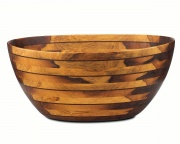Rosewood
Description
Any of several wood from trees of the genus Dalbergia. Rosewood timber has a reddish-purple color and produces a hard, strong, rose-like smell when cut. The wood has a fine grain, smooth texture, and polishes to a high gloss. Rosewood is used for cabinets, musical instruments, piano cases and veneer. It was popular during the late 18th and early 19th centuries. Though not currentl sold in large quantities, cultivation has continued the availability of some species. Many imposters are also sold as rosewood, even though they are more susceptible to rot and insects.
- Brazilian rosewood (Dalbergia nigra) tends to have a more variegated reddish color. A water extract of Brazilian rosewood with not fluoresce while that of most other rosewoods fluoresces a pale blue/green color.
- East Indian rosewood or Bombay blackwood (Dalbergia latifolia) tends to be a darker purple or brown with a tightly packed pore density. Though native to India, it is now cultivated elswhere.
- Honduras rosewood (Dalbergia stevensonii) has an uneven pore size. It has been used for musical instrument parts and ornaments.
- Madagascar rosewood (Dalbergia maritima) has a bright red color. Trade is illegal as of 2010.
Rosewood oil, used in perfumes, is obtained from the wood of a tree from a different genera, Aniba rosaeodora.
Personal Risks
The dust created from sanding rosewood can cause allergic reactions.
Synonyms and Related Terms
Brazilian rosewood (palisander, Rio rosewood, Bahia rosewood, Dalbergia nigra); East Indian rosewood (Bombay blackwood, sonokeling, Dalbergia latifolia); Honduras rosewood (Dalbergia stevensonii); Rosenholz (Deut.); bois de rose (Fr.); palissander (Ned.); shitan (Jap.); palisandro (Esp.); palissandro (It.); jacaranda
Physical and Chemical Properties
- Tree height = to 30m
- Density = 50-63 ppcf
Risks
Contact may cause allergic rashes. Inhalation of dust may cause asthma
Additional Images
Resources and Citations
- The Wood Database: Rosewoods - properties for each type)
- G.S.Brady, Materials Handbook, McGraw-Hill Book Co., New York, 1971 Comment: p. 670
- Ralph Mayer, A Dictionary of Art Terms and Techniques, Harper and Row Publishers, New York, 1969 (also 1945 printing)
- F. H. Titmuss, Commercial Timbers of the World, The Technical Press Ltd., London, 1965
- Wikipedia: http://en.wikipedia.org/wiki/Rosewood (Accessed Oct. 3, 2005 and October 2020)
- Michael McCann, Artist Beware, Watson-Guptill Publications, New York City, 1979
- George Savage, Art and Antique Restorer's Handbook, Rockliff Publishing Corp, London, 1954
- Random House, Webster's Encyclopedic Unabridged Dictionary of the English Language, Grammercy Book, New York, 1997
- The American Heritage Dictionary or Encarta, via Microsoft Bookshelf 98, Microsoft Corp., 1998
- WMuseum of Japanese Traditional Art Crafts at http://www.nihon-kogeikai.com/ (Jap. term)







